Page 1 :
UNIT-III, a. Nutriton, Health and Hygiene (Part-2), Factors Affecting Nutritional Well-Being:, The World Health Organisation has listed four main factors that are important for nutritional, well-being., i. Food and nutrient security: It means that each and every person (regardless of age) has, access to and can obtain adequate food and nutrients throughout the year, as per his/her, requirements to enable him/her to lead a healthy life., ii. Care for those who are vulnerable: It means that each individual needs loving care and, attention reflected by caring behaviour., iii. Health for all: It includes prevention of disease and curing disease when it occurs. Special, attention needs to be paid to infectious diseases since they can deplete the body of, nutrients and lead to poor health and poor nutritional status, iv. Safe environment focuses: It focuses on all aspects of environment including physical,, biological and chemical substances which may influence health., Nutritional Problems and Their Consequences:, In India, there exist several nutritional problems in the population. Undernutrition is a major, problem which is reflected in the high numbers of pregnant women who are undernourished and, have small babies with low birth weight as well as young children (below 3 years of age) who, are underweight and stunted. Similarly, considerable percentage of women too are underweight., There are other nutrition-related deficiencies such as iron deficiency anaemia, vitamin A, deficiency and consequent blindness and iodine deficiency., Undernutrition not only reduces body weight but has devastating effects on children’s, cognitive development, immunity and can also result in disability, e.g., blindness due to vitamin, A deficiency. Iodine deficiency is a threat to health and development, specially for young, children and pregnant women since it results in goitre, still birth, and miscarriage in women, and, deaf-mutism, mental retardation and cretinism in children. Iron deficiency also has negative, impact on health and well-being., Overnutrition is also not good. Intake in excess of requirements leads to several health, problems. In case of some nutrients if may lead to toxicity, and the person may become, overweight and even obese. Obesity in turn increases the risk of several diseases such as, diabetes, heart disease and hypertension. Double burden of malnutrition is the coexistence of, undernutrition (nutritional deficiencies) and overnutrition (diet-related chronic, noncommunicable diseases)., Nutrition and infection: Nutritional status does not depend only on sufficient supply of, food and nutrients but also on the person’s health status, to a great extent. Nutrition and, infection are intimately interlinked. Poor nutritional status decreases resistance and immunity,, and thus increases risk of infection and those undernourished are at the risk of contracting more, infections/diseases., Hygiene and Sanitation:, Hygiene refers to conditions and practices that help to maintain health and prevent the, spread of diseases. Hygiene is concerned with essentially two aspects: personal and, environmental., Personal hygiene refers to maintaining the body's cleanliness. It is important for, maintaining both physical and mental health., 1
Page 2 :
Environmental hygiene comprises external matter, both organic and inorganic, at, the domestic hygiene (home) and community levels. This includes physical factors such as, water, air, housing, radiation, etc., as well as biologic factors such as plants, bacteria, viruses,, insects, rodents and animals. Environmental health needs attention so as to create and maintain, ecological conditions that will promote health and prevent disease., Sanitation refers to public health conditions related to clean drinking water and adequate, treatment and disposal of human excreta and sewage., Intrinsic and Extrinsic Factors:, Prevention and control of disease has to address both intrinsic and extrinsic factors which are, linked with various diseases., Intrinsic and Extrinsic Factors Linked with Various Disease, Intrinsic and Extrinsic factors linked with various diseases, Intrinsic/host factors, , Extrinsic/environmental factors, , Age, sex, ethnicity, race, , Physical environment – air, water, soil,, housing, climate, geography, heat, light,, noise, radiation, , Biological factors such as heredity, blood, groups, enzymes, levels of various, substances in blood, e.g., cholesterol, Functioning of various organs and systems, , Biological environment includes the human, being, all other living beings such as, animals, rodents, insects, plants, viruses,, micro organisms, some of these act as disease-producing, agents, some as reservoirs of infection,, intermediate hosts and vectors of disease, , Social and economic characteristics, e.g.,, occupation, marital status, housing, , Psychosocial factors-emotional well-being,, cultural values, customs, habits, beliefs,, attitudes, religion, lifestyle, health services,, etc, , Lifestyle factors, e.g., nutrition, diet, physical, activity, living habits, use of addictive, substances such as drugs, alcohol, etc., , Food Hygiene:, Food Hygiene can be defined as handling, preparing and storing food or drink in a way that, best reduces the risk of consumers becoming sick from the food-borne disease. Food-borne, illnesses occur when we consume food that contains disease-causing (pathogenic) microorganisms., , i., ii., iii., , Factors that are needed for a food-borne illness to occur:, Either the organism or the toxin must be present in the food eaten., The number of pathogenic micro-organisms must be in sufficient numbers., The contaminated food must have been consumed in sufficient quantity., , 2
Page 3 :
Examples of poor personal and food handling practices are given below:, i. Use of food items that are spoiled/infected/unsafe, include water, spices,, seasonings, mixes. , ii. Improper storage leading to multiplication of disease causing micro- organisms. , iii. Not practising insect and vermin control., iv. Use of contaminated equipment, utensils and plates, spoons, glasses, v. Inadequate cooking., vi. Storage of foods at temperatures favourable to growth of microorganisms ( 4, to 600C)., , vii. Improper cooling., viii. Improper/inadequate heating/reheating of cooked foods/left overs., ix. Cross contamination., x. Leaving food uncovered., xi. Use of contaminated substances for garnishing., , 3















































